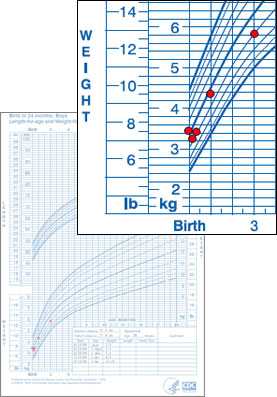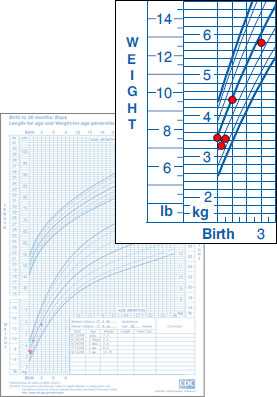Case Example 5: Early Lactation Difficulties
Omar is a 3-month-old breastfed infant. His mother's height is 5'2", and his father's height is 5'8". Omar's gestational age was 38 weeks. His weight measurements are as follows:
| Date | Age | Weight (pounds) | WHO Percentile | CDC Percentile |
|---|---|---|---|---|
| 6/15/2009 | Birth | 7.5 | 54 | 50 |
| 6/18/2009 | 3 days | 7.1 | 28 | 23 |
| 6/29/2009 | 2 weeks | 7.4 | 16 | 15 |
| 7/15/2009 | 1 month | 9.5 | 40 | 42 |
| 9/15/2009 | 3 months | 12.75 | 42 | 49 |
Based on the American Academy of Pediatrics (AAP) recommendation, Omar's first pediatrician visit was at 3 days of life. At that visit, his weight loss was 0.4 pounds (6.4 ounces) and not unusual for a breastfed infant. During the first visit, Omar's mother reported that she was concerned about breastfeeding and thought she "did not have enough milk." No lactation assessment was performed at this time.
At the two week visit, Omar had not yet regained his birth weight, suggesting the need for more follow-up and feeding assistance.1 In order to determine the cause of Omar's poor weight gain, his health care provider decides to:
- Conduct a formal feeding evaluation for position, latch, and milk transfer.
- Interview Omar's mother about intervals between feeds, the number of feeds per 24 hours, and Omar's elimination patterns.
Based on this information, the health care provider determined that Omar and his mother needed more breastfeeding assistance and support. The health care provider referred Omar and his mother to a lactation consultant. Omar and his mother were seen by the lactation consultant later that day.
With lactation management and support, Omar's weight gain improved; at one month of age and beyond, his weight shows an upward trend.
| Comparing Weight-for-Age Plotted on the WHO and CDC Growth Charts | |
|---|---|
WHO Weight-for-Age Growth Chart | CDC Weight-for-Age Growth Chart |
Using the WHO Weight-for-Age Growth Chart
At the two week visit, Omar's weight was plotted on the WHO weight-for-age growth chart. Omar's weight-for-age percentile was below the 25th percentile. At one month of age and beyond, Omar's weight-for-age tracks between the 25th and 50th percentiles showing that he is following a healthy growth pattern.
Using the CDC Weight-for-Age Growth Chart
At the two week visit, Omar's weight was plotted on the CDC weight-for-age growth chart. Omar's weight-for-age percentile was below the 25th percentile. At one month of age and beyond, Omar's weight-for-age tracks between the 25th and 50th percentiles showing that he is following a healthy growth pattern.
Comment: Plotting Omar's weight-for-age on the WHO and the CDC growth charts show a similar growth pattern.
For breastfed infants identified as growing slowly, health care providers need to carefully assess lactation adequacy, general health issues and ensure appropriate lactation management. Close monitoring of growth during this time is important. Indications for supplementation in term, healthy infants are few.
When supplementary feeding is necessary, the primary goals are to feed the baby and to optimize the maternal milk supply while determining the cause of poor feeding or inadequate milk transfer. The mother's own expressed human milk is the first choice for supplemental feeding. Standard formula should only be used when no other human milk options are available. Supplementation with glucose water is not appropriate.2
References
1The Academy of Breastfeeding Medicine Protocol Committee. ABM clinical protocol #2: guidelines for hospital discharge of the breastfeeding term newborn and mother: “the going home protocol”, revised 2007. Available at: http://www.bfmed.org/Media/Files/Protocols/protocol_2goinghome_revised07.pdf [PDF-68KB]
2The Academy of Breastfeeding Medicine Protocol Committee. ABM clinical protocol #3: hospital guidelines for the use of supplementary feedings in the healthy term breastfed neonate, revised 2009. Available at: http://www.bfmed.org/Media/Files/Protocols/Protocol%203%20English%20Supplementation.pdf [PDF-168KB]
- Page last reviewed: April 15, 2015
- Page last updated: April 15, 2015
- Content source:


 ShareCompartir
ShareCompartir

